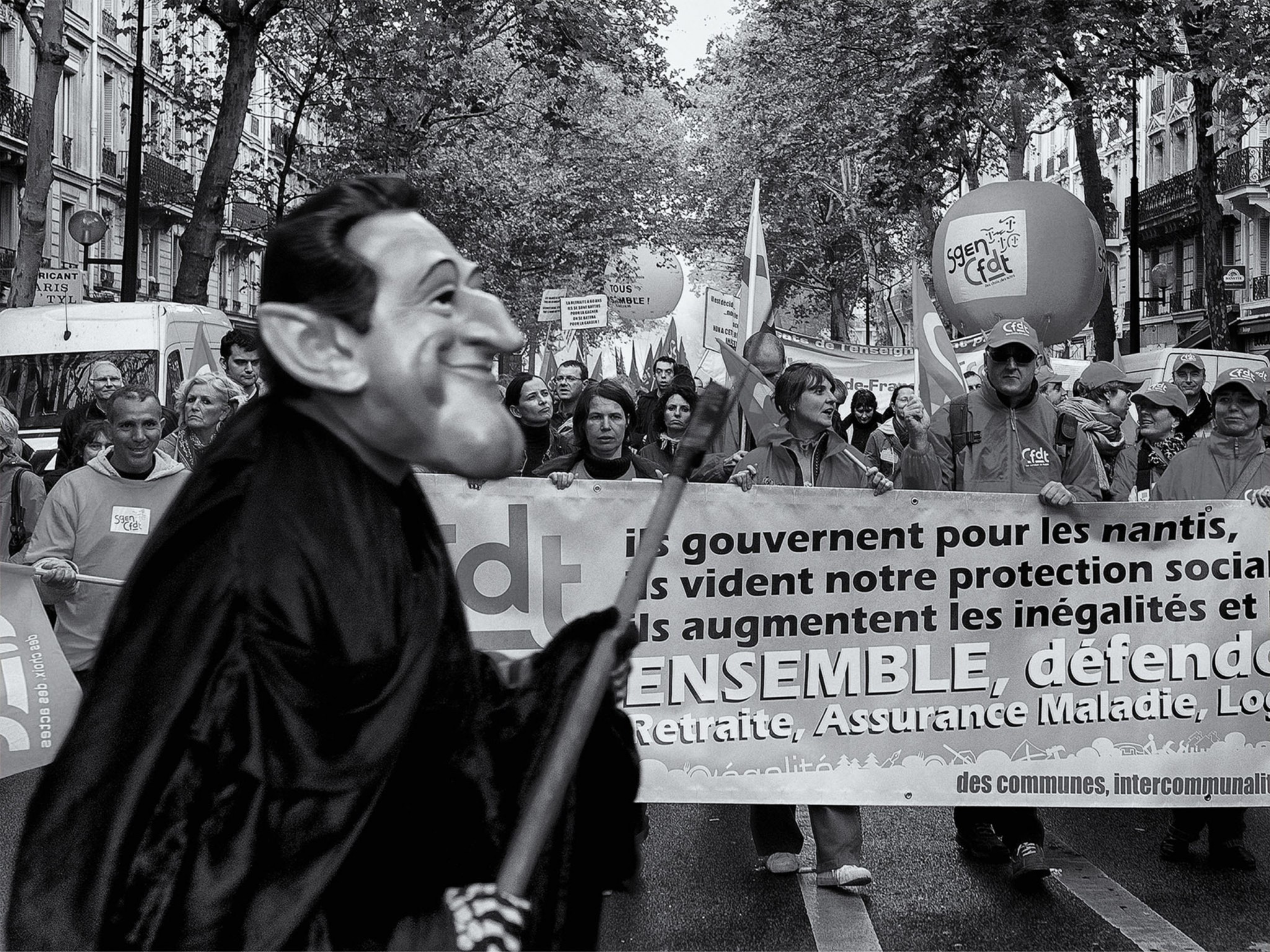- Portfolios
- Vus dans la rue
- 612_opg_20101016_Paris_Manifestations_Sarkozy_0108.jpg
Vus dans la rue |
La photo de rue, photo prise à l’extérieur avec une présence humaine directe ou indirecte, est également qualifiée en France de photo huma-niste. Nous connaissons tous de nombreux artistes adeptes de cette démarche : Willy Ronis, Robert Doisneau, Marc Riboud, Raymond Depardon, … et bien sûr le maître – Henri Cartier-Bresson - avec son manifeste « Images à la Sauvette ». Modestement, j’ai rassemblé dans ce Portfolio – « Vus dans la rue » - 20 de mes photos prises dans la rue et qui révèlent des personnages dans des situations cocasses, saugrenues ; avec l’accord du (des) sujet(s) ou au contraire à la « sauvette ». La photographie de rue est un exercice très exigeant pour le photographe ; être attentif à son environnement, vigilant à tout mouvement inhabituel, ... Le photographe peut « chasser à l’affût » - la méthode préférée de Cartier-Bresson ou « chasser en battue ». La première méthode est favorable à des clichés bien composés et bien exposés. La seconde oblige à prérégler son appareil et par conséquent, une probabilité d’obtenir a priori un cliché plus moyen. Heureusement, la puissance des logiciels de traitement actuels permet d’obtenir néanmoins d’excellents clichés.
Seen in the street |
Street photography, a photo taken outdoors with a direct or indirect human presence, is also qualified in France as humanist photography. We all know many artists who follow this approach: Willy Ronis, Robert Doisneau, Marc Riboud, Raymond Depardon, ... and of course the master – Henri Cartier-Bresson - with his manifesto «Images à la Sauvette». Modestly, I have brought together in this Portfolio – “Seen in the street” - 20 of my photos taken in the street and which reveal characters in funny, absurd situations; with the agreement of the subject(s) or on the contrary “incognito”. Street photography is a very demanding exercise for the photographer; be attentive to your environment, vigilant for any unusual movement, ... The photographer can “hunt on the lookout” - Cartier-Bresson’s favorite method or “beaten hunt”. The first method is favorable for well-composed and well-exposed shots. The second requires you to preset your camera and therefore, a probability of obtaining a priori a more average shot. Fortunately, the power of current processing software still allows you to obtain excellent photos.
Visto per strada |
Fotografia di strada, foto scattata all'esterno con una presenza umana diretta o indiretta, è qualificata anche in Francia come foto umanista. Conosciamo tutti molti artisti che seguono questo approccio: Willy Ronis, Robert Doisneau, Marc Riboud, Raymond Depardon, ... e ovviamente il maestro – Henri Cartier-Bresson - con il suo manifesto « Immagini à la Sauvette ». Modestamente, ho riunito in questo Portfolio – “Visto per strada” - 20 le mie foto scattate per strada e che rivelano i personaggi in situazioni divertenti e assurde; con il consenso del/i soggetto/i o al contrario “incognito”. La fotografia di strada è un esercizio molto impegnativo per il fotografo; sii attento al tuo ambiente, vigile per qualsiasi movimento insolito, ... Il fotografo può “cacciare alla ricerca” - Il metodo preferito di Cartier-Bresson o “caccia alla battuta”. Il primo metodo è favorevole per scatti ben composti e ben esposti. Il secondo richiede di preimpostare la fotocamera e quindi una probabilità di ottenere a priori uno scatto più mediocre. Fortunatamente, la potenza degli attuali software di elaborazione consente ancora di ottenere foto eccellenti.
Auf der Straße gesehen |
Straßenfotografie, Foto draußen aufgenommen mit eine direkte oder indirekte menschliche Präsenz, wird in Frankreich auch als humanistisches Foto qualifiziert. Wir alle kennen viele Künstler, die diesem Ansatz folgen: Willy Ronis, Robert Doisneau, Marc Riboud, Raymond Depardon, ... und natürlich der Meister – Henri Cartier-Bresson – mit seinem Manifest « Bilder à la Sauvette ». Bescheidenerweise habe ich in diesem Portfolio – „Auf der Straße gesehen“ – 20 meiner auf der Straße aufgenommenen Fotos zusammengestellt, die Charaktere offenbaren in lustigen, absurden Situationen; mit Zustimmung des/der Subjekt(e) oder im Gegenteil „heimlich“. Straßenfotografie ist für den Fotografen eine sehr anspruchsvolle Tätigkeit; Achten Sie auf Ihre Umgebung, achten Sie auf ungewöhnliche Bewegungen ... Der Fotograf kann „auf der Hut sein“ – Cartier-Bressons Lieblingsmethode oder „geschlagene Jagd“. Die erste Methode eignet sich für gut komponierte und gut belichtete Aufnahmen. Bei der zweiten Einstellung müssen Sie Ihre Kamera voreinstellen und damit die Wahrscheinlichkeit erhöhen, a priori eine durchschnittlichere Aufnahme zu erhalten. Glücklicherweise ermöglicht Ihnen die Leistungsfähigkeit aktueller Verarbeitungssoftware immer noch, hervorragende Fotos zu erhalten.
